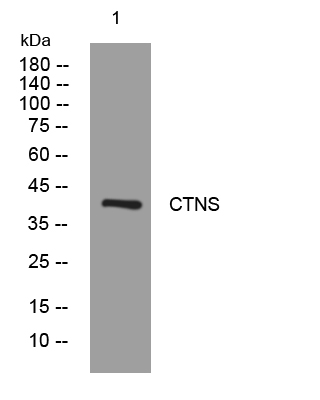- Home
- About
- Promotions
-
Products
-
Elisa Kits
- |
-
Primary antibodies
- |
-
Secondary antibodies
- |
-
Proteins
- |
-
IHC reagents
- |
-
WB reagents
- PonceauS Staining Solution
- PBST Washing Buffer, 10X
- 1.5M Tris-HCl Buffer, pH8.8
- 1M Tris-HCl Buffer, pH6.8
- 10% SDS Solution
- Prestained Protein Marker
- TBST Washing Buffer, 10X
- SDS PAGE Loading Buffer, 5X
- Stripping Buffered Solution
- Tris Buffer, pH7.4, 10X
- Total Protein Extraction Kit
- Running Buffer, 10X
- Transfer Buffer, 10X
- 30% Acr-Bis(29:1) Solution
- Tris电泳液速溶颗粒
- PBS(1X, premixed powder)
- TBS(1X, premixed powder)
- 快速封闭液
- 转膜液速溶颗粒
- Chemical reagents
- News
- Distributor
- Resources
- Contact
- Home
- >
- Info
- >
- CTNS rabbit pAb
- >
- Go Back
CTNS rabbit pAb
- Catalog No.:YT7111
- Applications:WB
- Reactivity:Human;Mouse
- Immunogen:
- Synthesized peptide derived from human CTNS AA range: 234-284
- Specificity:
- This antibody detects endogenous levels of CTNS at Human/Mouse
- Formulation:
- Liquid in PBS containing 50% glycerol, 0.5% BSA and 0.02% sodium azide.
- Source:
- Polyclonal, Rabbit,IgG
- Purification:
- The antibody was affinity-purified from rabbit antiserum by affinity-chromatography using epitope-specific immunogen.
- Storage Stability:
- -15°C to -25°C/1 year(Do not lower than -25°C)
- Molecular Weight(Da):
- 40kD
- Background:
- This gene encodes a seven-transmembrane domain protein that functions to transport cystine out of lysosomes. Its activity is driven by the H+ electrochemical gradient of the lysosomal membrane. Mutations in this gene cause cystinosis, a lysosomal storage disorder. Alternative splicing results in multiple transcript variants. [provided by RefSeq, Jul 2009],
- Function:
- disease:Defects in CTNS are the cause of cystinosis [MIM:219800, 219900, 219750]. This autosomal recessive disorder results from defective lysosomal transport of cystine. The classical nephropathic form is characterized by renal failure at 10 years of age and other systemic complications. Milder phenotype exist such as intermediate cystinosis, with later onset of renal disease and benign or non-nephropathic cystinosis, with symptoms related only to corneal crystals and photophobia.,function:Thought to transport cystine out of lysosomes.,similarity:Belongs to the cystinosin family.,similarity:Contains 2 PQ-loop domains.,tissue specificity:Strongly expressed in pancreas, kidney (adult and fetal) and in skeletal muscle. Expressed at lower levels in placenta and heart. Weakly expressed in lung, liver and brain (adult and fetal).,
- Subcellular Location:
- [Isoform 1]: Lysosome membrane ; Multi-pass membrane protein . Melanosome membrane ; Multi-pass membrane protein . AP-3 complex is required for localization to the lysosome. .; [Isoform 2]: Lysosome membrane ; Multi-pass membrane protein . Cell membrane ; Multi-pass membrane protein .
- Expression:
- Strongly expressed in pancreas, kidney (adult and fetal), skeletal muscle, melanocytes and keratinocytes (PubMed:22649030). Expressed at lower levels in placenta and heart. Weakly expressed in lung, liver and brain (adult and fetal) (PubMed:22649030). ; [Isoform 2]: Represents 5-20 % of CTNS transcripts, with the exception of the testis that expresses both isoforms in equal proportions.

- Western blot analysis of lysates from HEK293 cells, primary antibody was diluted at 1:1000, 4°over night




